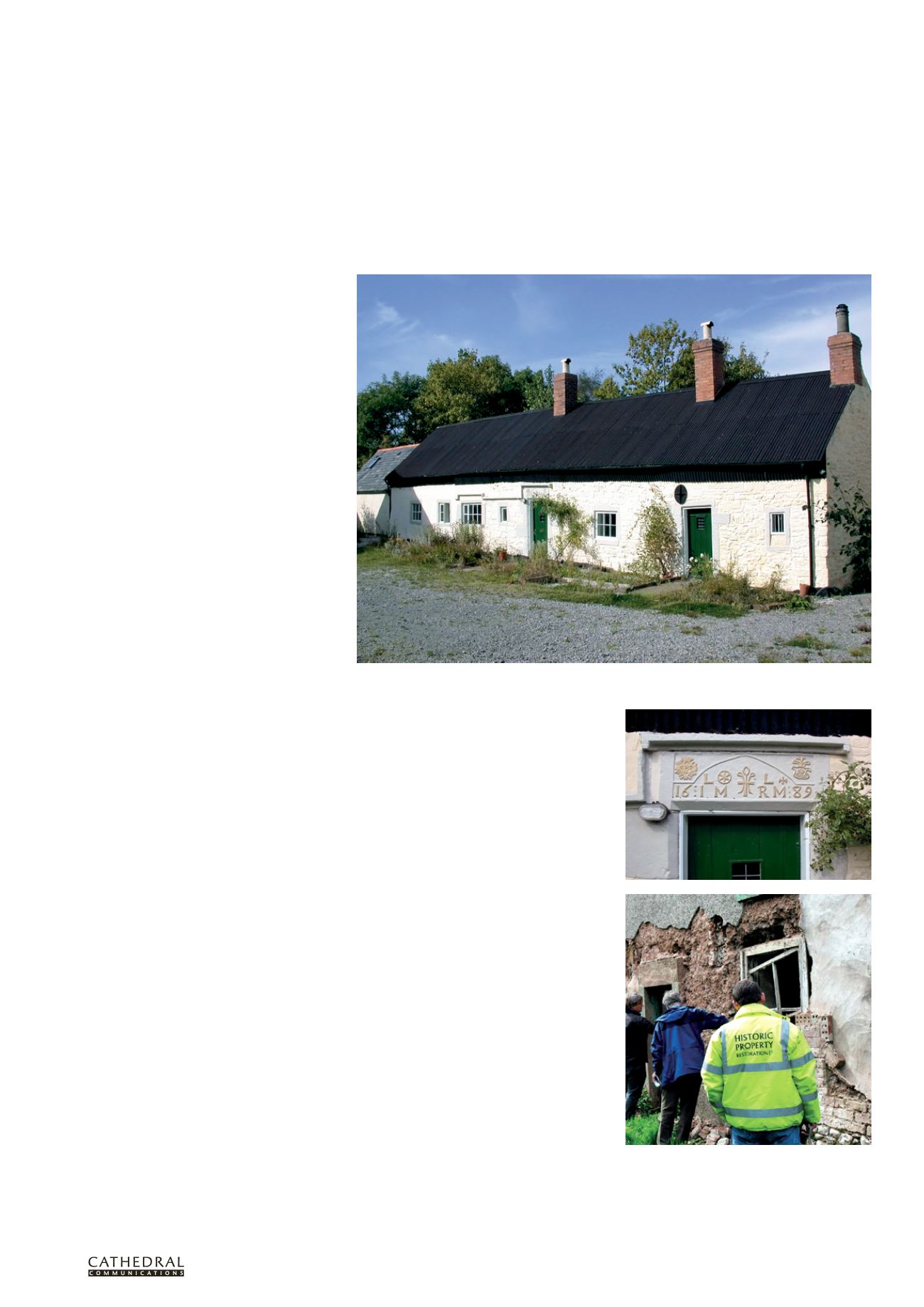
T W E N T Y F I R S T E D I T I O N
T H E B U I L D I N G C O N S E R VAT I O N D I R E C T O R Y 2 0 1 4
7 5
3.1
STRUCTURE & FABRIC :
ROOFING
REPAIRING CLAY BUILDINGS
and CUMBRIA’S CLAY DABBINS
PETER MESSENGER
A
LTHOUGH THIS
article focuses on the
revival of interest in clay buildings in
Cumbria, the repair and maintenance
issues which are discussed here are relevant to
all variants of earth construction in the UK..
Most clay dabbins, as they are known
locally, are quite modest structures but some
have survived remarkably well (right). Nearly
all are rendered and it is often impossible to
detect that a building is built of clay until
the building starts to decay. When render is
removed or falls off, or a clay wall collapses
(sometimes without warning) the structure
becomes visible. The horizontal clay layers,
each of which is usually 50–150mm deep, are
separated by thin layers of straw which are
only millimetres thick.
Examples of this form of construction
have been found in Wales and Scotland but
they only appear to exist in England on the
Solway Plain. They were once very common on
both sides of the Solway but building clearance
and improvement on the Scottish side has
reduced this to three surviving examples.
In Cumbria several hundred examples have
survived, dating from the 16th to the 19th
centuries, and include cottages, farmhouses
and farm buildings, many of which are cruck
framed (overleaf, centre). Numbers have been
diminishing over the last century or longer, as
the use of unburnt clay as a building material
eventually ceased and the craftsmen capable of
maintaining these buildings died out.
BASIC CARE
In temperate climates the main cause of decay
in earth building is water penetration. It is
important to protect the top and bottom of any
earth wall and to ensure that any treatment
applied to the interior or exterior of a clay wall
is breathable. When water does occasionally
find a way in, it can dry out naturally as long as
the water vapour can reach the surface of the
wall and evaporate. If there are signs of water
penetration these need to be investigated and
treated. Cement render is a common cause of
damp problems as it tends to prevent water
vapour from reaching the surface. Unable to
dry out, the wall begins to deteriorate and, if
the problem is not addressed, it will eventually
fail, often quite dramatically.
If a clay wall is very damp and it is
cement rendered, care should be taken when
investigating the state of the clay underneath
as, in the worst cases, saturated clay can
literally pour out. Removing patches of
render from the upper wall first and gradually
working down to the plinth is the preferred
course of action. If the clay wall is excessively
damp and soft then it should be left to dry
out for several days. Once this section is dry
then the removal of render can resume. Once
the wall has dried out the strength of the clay
wall will gradually return and it will then be
possible to address any other problems that
have been uncovered.
The most appropriate finish for a clay
wall is the traditional solution of using either
an earth or lime render or a limewash. No
impervious coatings of any description should
ever be used.
Protecting the top of the wall with deep
eaves helps to keep the top and much of the
face of the wall dry. If this is not possible then
adequately sized, well maintained guttering
and downpipes are paramount. Most clay
buildings have a stone plinth on which the
clay wall is set, and in dabbins this is generally
about half a metre high; if this is free of
vegetation and there is good drainage around
the building this should prevent any damp
attacking the base of the clay wall.
THE CLAY DABBIN PROJECT
A survey carried out for English Heritage by
Oxford Archaeology North in 2006 identified
just over 300 surviving clay dabbin structures
in Cumbria. A significant number were in a
poor condition and although it was possible to
give advice on how repairs should be carried
out, not a single suitable contractor could be
found in the region.
Traditional long-house at Durdar, Cumbria, which has since been thatched and, below, the long-house’s
1689 date stone
Cottage at Castletown, Cumbria: the cement render
fell away to reveal a waterlogged clay wall. After a
week this had dried out completely. (Photo: Heritage
Skills Initiative)


